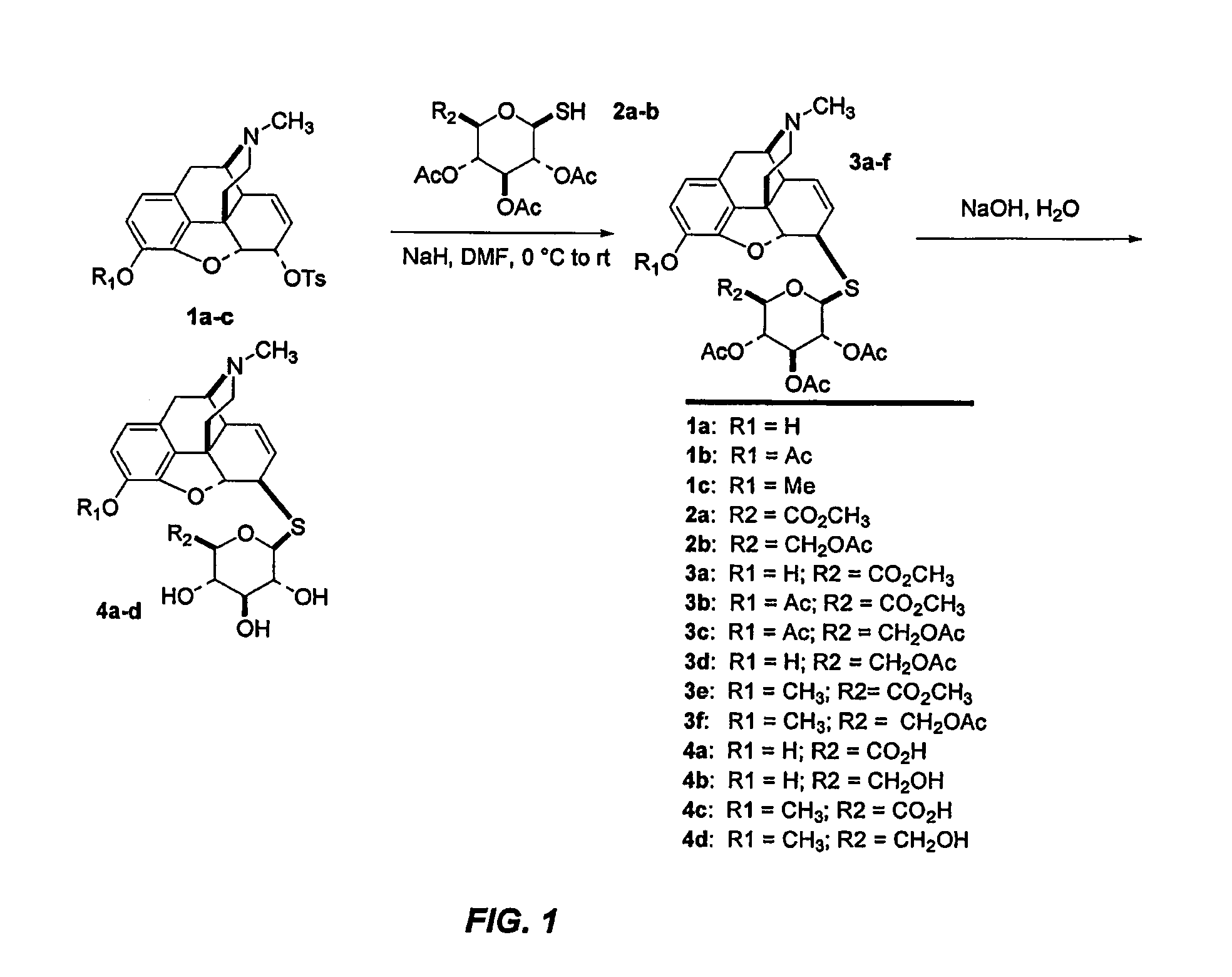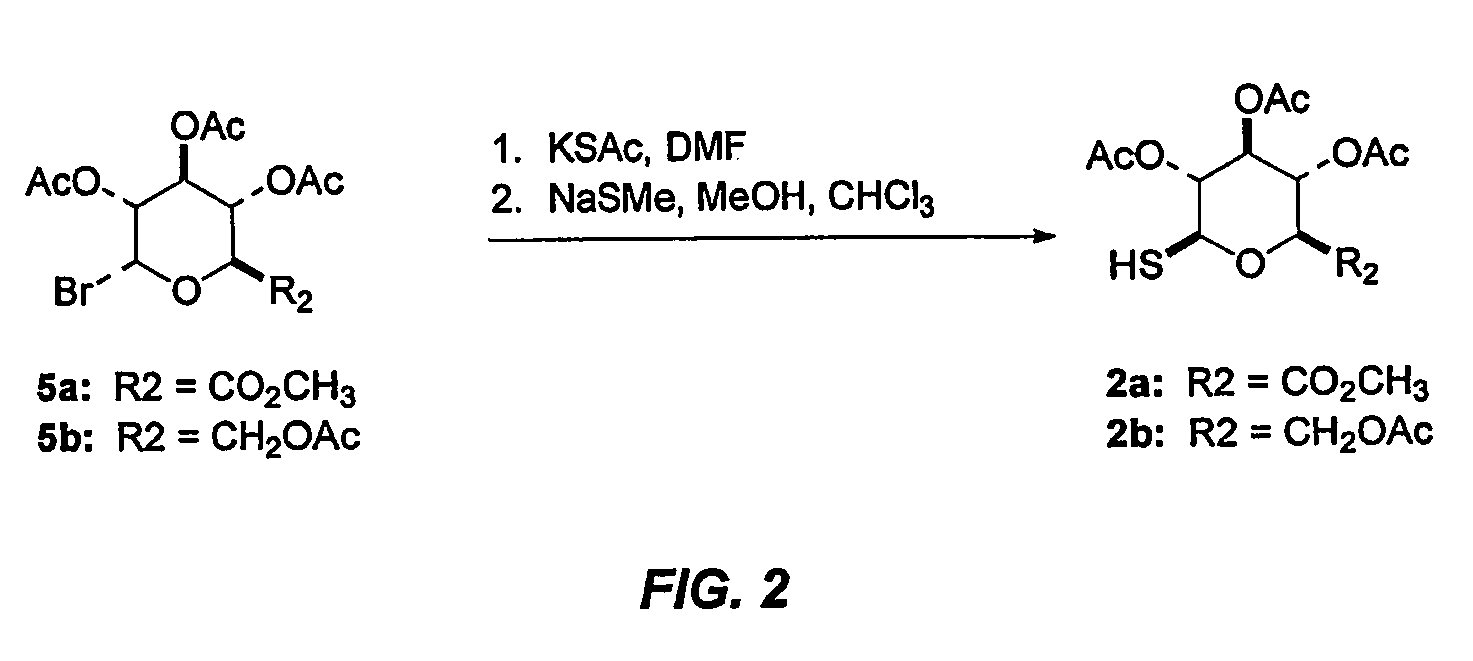Synthesis of metabolically stable analgesics, pain medications and other agents
a metabolically stable, analgesic technology, applied in the direction of biocide, drug composition, sugar derivate, etc., can solve the problems of limited morphine availability and optimal use, limited injectable morphine amount, and abuse potential
- Summary
- Abstract
- Description
- Claims
- Application Information
AI Technical Summary
Benefits of technology
Problems solved by technology
Method used
Image
Examples
example 1
6β-S-(Methyl-2′,3′,4′-tri-O-acetyl-β-D-glucopyranosyluronate)morphine 3a
[0107]A 60% dispersion of NaH (46 mg, 1.16 mmol) was added to a 0° C. DMF solution of 2a (424 mg, 1.21 mmol) and the resulting red mixture was stirred for 10 min. To the mixture of the thiol thus formed was added a 0° C. DMF (8 mL) solution of 1b (183 mg, 0.416 mmol) by syringe over 1 min. The resulting solution was stirred for 4 h while warming to rt. The reaction was poured into 0.5% aqueous HC (20 mL) and the pH was raised to 9 by the careful addition of solid NaHCO3. The mixture was extracted with CH2Cl2 (3×50 mL) and the combined organic layers were washed with H2O (10 mL), brine (10 mL), dried over Na2SO4, filtered and concentrated to a grey solid that was purified by flash chromatography (15×2.5 cm SiO2, 60:1 to 20:1 CH2Cl2 / EtOH) to provide 3a as an off-white solid (144 mg, 56%). An analytical sample of 3a was obtained as a white solid by recrystallization from absolute EtOH: Rf=0.10 (20:1 CH2Cl2 / MeOH); m...
example 2
3-O-Acetyl-6β-S-(methyl-2′,3′,4′-tri-O-acetyl-β-D-glucopyranosyluronate) morphine 3b
[0108]According to the procedure described for 3a, NaH (53 mg, 1.33 mmol), 1a (484 mg, 1.38 mmol) and 2a (246 mg, 0.51 mmol) provided 3b as an off-white powder (211 mg, 63%): Rf=0.33 (20:1 CH2Cl2 / EtOH); mp 194° C. (decomposed); 1H NMR (CDCl3) δ 6.74 (d, J=8.2 Hz, 1H), 6.58 (d, J=8.2 Hz, 1H), 5.83-5.80 (m, 1H), 5.53 (dd, J=1.5, 10.2 Hz, 1H), 5.29-5.21 (m, 2H), 5.09 (s, 1H), 5.00 (t, 1H), 4.72 (d, J=10.3 Hz, 1H), 4.06 (d, J=9.3 Hz, 1H), 3.76-3.73 (4H), 3.33 (m, 1H), 3.07-3.03 (2H), 2.60-2.58 (m, 1H), 2.44 (s, 3H), 2.37-2.20 (s, 3H over m, 2H), 2.15 (dt, J=3.7, 11.8 Hz, 1H), 2.04 (s, 3H), 2.03 (s, 3H), 2.02 (s, 3H), 1.80 (d, J=11.6 Hz, 1H); 13C NMR (CDCl3) δ 170.3, 169.5, 169.4, 168.8, 167.0, 149.0, 133.0, 132.6, 132.0, 131.8, 128.0, 121.8, 119.5, 94.5, 85.1, 76.2, 73.3, 70.3, 69.4, 59.0, 53.0, 46.9, 45.6, 44.5, 43.2, 40.0, 35.7, 20.93, 20.90, 20.8, 20.7; MS (ESI) m / z=660 [M+H+]; Anal. (C32H37NO12S) cal...
example 3
3-O-Acetyl-6β-S-(2′,3′,4′,5′-tetra-O-acetyl-β-D-glucopyranosyl)-6β-thiomorphine 3c
[0109]According to the method described for 3a, thiol 2b (500 mg, 1.37 mmol), NaH (53 mg, 1.32 mmol) and tosylate 1b (246 mg, 0.51 mmol) gave 3c as an off-white foam (255 mg, 74%): Rf=0.20 (20:1 CH2Cl2 / MeOH); mp=151.9° C.; 1H NMR (CDCl3) δ 6.73 (d, J=8.2 Hz, 1H), 6.58 (d, J=8.2 Hz, 1H), 5.83-5.79 (m, 1H), 5.50 (dd, J=1.8, 9.7 Hz, 1H), 5.24-5.17 (m, 2H), 5.04 (t, J=9.9 Hz, 1H), 4.96 (t, J=9.9 Hz, 1H), 4.69 (d, J=10.2 Hz, 1H), 4.19 (d, J=4.2 Hz, 2H), 3.79-3.75 (m, 1H), 3.71 (d, J=6.0 Hz, 1H), 3.30 (dd, J=3.3, 5.6 Hz, 1H), 3.04 (d, J=18.8 Hz, 1H), 2.57 (dd, J=4.0, 12.2 Hz, 1H), 2.42 (s, 3H), 2.34-2.29 (m, 2H), 2.14-2.11 (m, 1H), 2.07 (s, 6H), 2.05 (s, 6H), 2.00 (s, 6H), 1.80-1.77 (m, 1H); 13C NMR (CDCl3) δ 170.8, 170.1, 169.5, 169.3, 169.5, 148.8, 132.8, 132.1, 131.7, 131.6, 127.9, 121.6, 119.3, 94.4, 85.1, 75.9, 73.8, 70.3, 68.5, 62.4, 58.8, 46.7, 45.8, 44.3, 43.0, 39.7, 35.6, 20.7, 20.6, 20.5; MS m / z=67...
PUM
| Property | Measurement | Unit |
|---|---|---|
| pH | aaaaa | aaaaa |
| pH | aaaaa | aaaaa |
| pH | aaaaa | aaaaa |
Abstract
Description
Claims
Application Information
 Login to View More
Login to View More - R&D
- Intellectual Property
- Life Sciences
- Materials
- Tech Scout
- Unparalleled Data Quality
- Higher Quality Content
- 60% Fewer Hallucinations
Browse by: Latest US Patents, China's latest patents, Technical Efficacy Thesaurus, Application Domain, Technology Topic, Popular Technical Reports.
© 2025 PatSnap. All rights reserved.Legal|Privacy policy|Modern Slavery Act Transparency Statement|Sitemap|About US| Contact US: help@patsnap.com



